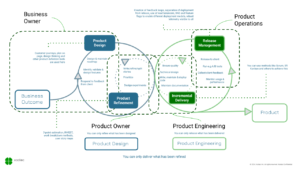In the first half of this series, we talked about five benefits you can get from your business agility journey. Now, as we introduced last week, we are switching topics to talk about the first of five aspects that support you in your journey or will be barriers if not overcome. In this article, we’ll be exploring feedback loops, an essential element to business agility.
Big changes come from a series of small changes. Large transformative programs are too disruptive and take too long to produce results. To see the results of your series of small changes, you need feedback loops. Without them, you won’t be able to see if you are going in the right direction and course-correct as you go.
Feedback loops inform you of what is happening in your system of work. They tell your developers the impact of their changes, inform your product team what your customers are looking for, and tell operations where to focus.
So what makes a “good” feedback loop?
Minimize noise
When assessing any kind of result, it’s important to be able to detect noise and where it’s coming from. Noise is a general term for outlying variables that could affect the result.
For example, imagine you want to lose weight. You reduce your calorie intake and start to exercise. To tell whether you are succeeding you need a feedback loop, so you measure your weight before breakfast. Now if you choose to measure your weight at different times of day, before and after meals, you would introduce a lot of noise.
The same is true for feedback loops in business. For example, noise makes it a challenge to know exactly what the customer is willing to pay for:
- Customer feedback surveys and NPS scores customers may tell you what they think you want to hear, and not really what they feel.
- Data and trends on consumer behavior are much more reliable but not always available.
- Watching what your customers do, where they go on your website, and what they come back to gives you some guidance to behavior.
Gathering all three provides multiple views will help reduce the inherent noise.
Feedback loops are best when they are short
Consider the impact of shortening the time it takes you to get a product change into a customer’s hands. If you wait until everything is ready before seeking feedback, you may find you’ve been building something your customers do not find valuable. To counter this, you need to get feedback early and often.
When introducing a change to your system of work, think about what indicators might be leading indicators that you are getting the behavior change you are looking for and which might be lagging indicators that you’ve been successful.
Feedback loops have to be transparent
No matter how long your company’s feedback loops are, they always have to be transparent. Your teams have to know when they can expect to receive feedback, what results to expect, and what action to take. This transparency is important because this ensures that the teams don’t:
- Make hasty choices believing that they haven’t received any results.
- Misinterpret the results they get
- Take the wrong action in response
The fix for this is easy. Involve teams in determining the measurement and response!
Conclusion
Feedback loops are important to business agility in any organization, but without implementing them effectively, your business won’t be maximizing its benefits. A little forethought and a willingness to revisit initial ideas will guide you well.
If you want to learn more about business agility and helping your business grow, check out Definitely, Maybe Agile’s episode about this topic here.




